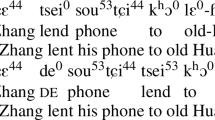Abstract
In this paper, I discuss the formation of the “NP1exp+V+NP2” construction from the perspective of historical development and formal syntax. I argue that the “NP1exp+V+NP2” construction comes from a morphological or lexical causative construction and has a competitive relationship with the causative constructions in the process of the historical development of Chinese. The “V+NPtheme” constructions are actually two-place unaccusative sentences with omitted causer or experiencer. Only the “NPtheme+V” construction is the real one-place unaccusative construction in which the NPtheme generates in the object position in deep structure and moves to the subject position in surface structure because of case requirement.
Access this chapter
Tax calculation will be finalised at checkout
Purchases are for personal use only
Preview
Unable to display preview. Download preview PDF.
Similar content being viewed by others
References
Xu, Z.R.: “Wangmian’s father died” (Wangmian si le fuqin). Chinese Knowledge (Yuwen zhishi) (9), 34–38 (1956). (in Chinese)
Guo, J.M.: Possesor-subject and possessum-object constructions (Lingshu zhubin ju). Studies of Chinese Language (Zhongguo Yuwen) (1), 24–29 (1990). (in Chinese)
Xu, J.: Two kinds of retained object constructions and theoretical issues (Liangzhong baoliu binyu jushi ji xiangguan jufa lilun wenti). Modern Linguistics (Dangdai yuyanxue) 1(1), 16–29 (1999). (in Chinese)
Han, J.Q.: A Study of Possessor Raising Movement in relation to Case Theory (Lingyou mingci tisheng yiwei yu ge lilun). Modern Foreign Languages (Xiandai waiyu) 23(3), 261–272 (2000). (in Chinese)
Wen, B.L., Chen, Z.L: A MP Approach to Possessor Raising in Chinese (Lingyou mingci yiwei: jiyu MP de fenxi). Modern Foreign Languages (Xiandai waiyu) 24(4), 412–416 (2001) (in Chinese)
Pan, H.H., Han, J.Q: The Syntax of Surface Unaccusative Constructions (Xianxing fei binge dongci jiegou de jufa yanjiu). Studies in Language and Linguistics (Yuyan yanjiu) 25(3), 1–13 (2005). (in Chinese)
Shen, J.X: The Generative Mechanism of Sentences like “Wangmian si le fuqin” (“wangmian si le fuqin” de shengcheng fangshi). Studies of Chinese Language (Zhongguo yuwen) (4), 291–300 (2006). (in Chinese)
Pan, H.H., Han, J.Q.: The Syntactic Mechanism of Retained Object Constructions in Chinese (Hanyu baoliu binyu jiegou de jufa shengcheng jizhi). Studies of Chinese Language (Zhongguo yuwen) (4), 511–522 (2008). (in Chinese)
Han, J.Q., Pan, H.H.: A Minimalist Account of the Syntactic Derivation of Chinese Retained Object Constructions (Hanyu baoliu binyu jiegou jufa shengcheng de zui jian fenxi). Language Teaching and Linguistic Studies (Yuwen jiaoxue yu yanjiu) (3), 41–53 (2016). (in Chinese)
Zhuang, H.B.: On the Construction “Wangmian si le fuqin”: An Account Based on the Split CP Hypothesis (“Wangmian si le fuqin” jushi de CP fenlie jiashuo jieshi). Foreign Language and Literature Studies (Waiguo yuyan wenxue) (3), 242–250 (2013). (in Chinese)
Zhu, X.F.: Light Verb Syntax of Intransitives containing Objects (Qing dongci he hanyu bu jiwu dongci dai binyu xianxiang). Modern Foreign Languages (Xiandai waiyu) 28(3), 221–231 (2005) (in Chinese)
Huang, C.T.: Thematic Structures of Verbs in Chinese and their Syntactic Projections (Hanyu dongci de tiyuan jiegou yu qi jufa biaoxian). Lingui (4), 511–522 (2008) (In Chinese)stic Sciences (Yuyan kexue) 6(4), 3–21 (2007). (in Chinese)
Zhang, H.: Difference among the Object In-situ Constructions in Mandarin Chinese. In: Xiao, Y., Smithfield (eds.) Proceedings of the 21st North American Conference on Chinese Linguistics, vol. 2, pp. 417–435. Bryant University, Island (2009)
Shen, J.X.: The Logical Order and the Historical Sequence (Luoji xianhou he lishi xianhou). Journal of Foreign Languages (Waiguoyu) 31(5), 91–92 (2008) (in Chinese)
Yu, L.M., Lü, J.J.: A Historical Study about “Wangmian’s father died” (“Wangmian si le fuqin” ju de lishi kaocha). Studies of Chinese Language (Zhongguo yuwen) (1), 32–42 (2011). (in Chinese)
Yang, Z.L., Wu, F.X.: Possesor-subject and possessum-object constructions in Ancient Chinese (Xianqin hanyu zhong de ling zhu shu bin ju). Studies of Historical Linguistics (Lishi yuyanxue yanjiu) (8), 70–79 (2014). (in Chinese)
Shi,Y.Z.: On Evidence of Linguistic Hypothesis (Yuyanxue jiashe zhong de zhengju wenti). Linguistic Sciences (Yuyan kexue) 6(4), 39–51 (2007) (in Chinese)
Liu, X.L.: Remarks about the Generation of “Wangmian’s father died” (Ye tan “wangmian si le fuqin” de shengcheng fangshi). Studies of Chinese Language (Zhongguo yuwen) (5), 440–443 (2007). (in Chinese)
Shuai, Z.G.: The Evolution Process and Mechanisms of “Wangmian’s father died” (“Wangmian si le fuqin” de yansheng guocheng he jizhi). Linguistic Sciences (Yuyan kexue) 7(3), 259–269 (2008). (in Chinese)
Mei, T.L.: Chronological Strata in Derivation by Tone Change (Sisheng bieyi de shijian cengci). Studies of Chinese Language (Zhongguo yuwen) (6), 427–443 (1980)
Mei, T.L: The Origin of Voicing Alternation in Old Chinese Verbs (Shanggu hanyu dongci zhuo qing bieyi de laiyuan). Minority Languages of China (Minzu yuwen) (3), 3–20 (2008). (in Chinese)
Jackendoff, R.: Semantic Interpretation in Generative Grammar. MIT Press, Cambridge (1972)
Grimshaw, J.: Argument Structure. MIT Press, Cambridge (1990)
Li, Z.F.: Intransitive Verbs and Their Causative Use in Archaic Chinese (Xianqin hanyu de zidongci jiqi shidong yongfa). Linguistics Series (Yuyanxue luncong) (10), 117–144 (1983) (in Chinese)
Yang, S.Y.: The Unaccusative Phenomenon: a study on the relationship between syntax and semantics (Cong fei binge dongci xianxiang kan yuyi ju jufa jiegou zhi jian de guanxi). Modern Linguistics (Dangdai yuyanxue) 1(1), 30–43 (1999). (in Chinese)
Perlmutter, D.: Impersonal passives and the unaccusative hypothesis. In: Proceedings of the 4th Annual Meeting of the Berkeley Linguistics Society, pp. 157–190 (1978)
Author information
Authors and Affiliations
Corresponding author
Editor information
Editors and Affiliations
Rights and permissions
Copyright information
© 2016 Springer International Publishing AG
About this paper
Cite this paper
Liu, M. (2016). The formation of the “NP1exp+V+NP2” construction in Chinese. In: Dong, M., Lin, J., Tang, X. (eds) Chinese Lexical Semantics. CLSW 2016. Lecture Notes in Computer Science(), vol 10085. Springer, Cham. https://doi.org/10.1007/978-3-319-49508-8_14
Download citation
DOI: https://doi.org/10.1007/978-3-319-49508-8_14
Published:
Publisher Name: Springer, Cham
Print ISBN: 978-3-319-49507-1
Online ISBN: 978-3-319-49508-8
eBook Packages: Computer ScienceComputer Science (R0)




